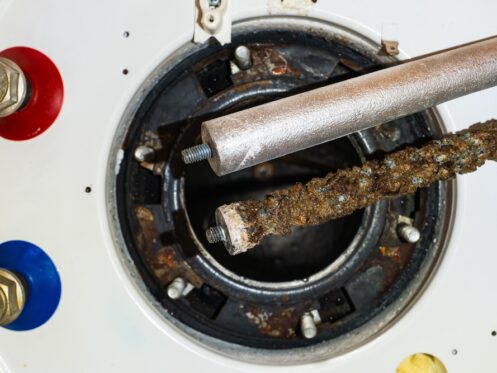The anode rod in your water heater is one of the system’s most important components, but you may not have even known about it. This small but vital part helps ensure your water heater’s durability and efficiency by preventing corrosion and extending the unit’s lifespan. Despite being essential for the longevity of your system, anode rods are sometimes overlooked when it comes to water heater repairs. In this guide, we’ll explain everything you need to know about water heater anode rods and when they should be replaced.
What Is a Water Heater Anode Rod?
An anode rod is a cylindrical aluminum, magnesium, or zinc component within your water heater’s tank. Through a process known as galvanic corrosion, the rod draws corrosive action to itself instead of other parts of the tank. In other words, the anode rod becomes rusty and degraded to protect the water heater’s other components. This process gives anode rods their other name: ‘sacrificial anodes’. What does an anode rod do besides preventing rusted components? Different metals are used to help in different situations. Durable aluminum is often used in homes with a hard water supply, while magnesium rods are best for homes with soft water. Zinc rods are also sometimes used to reduce sulfuric smells in the water.
Signs That the Anode Rod Needs Replacing
Because they are designed to eventually be destroyed by corrosion, anode rods must be periodically replaced. You’ll know it’s time to upgrade your water heater anode rod if you notice these symptoms:
- Reduced hot water availability
- Rusty, discolored water
- Sulfuric smell from the water
These signs might clue you in to an issue with your anode rod, but the only way to be sure is with a physical inspection. Minor pitting and wear is fine, but if your anode rod is extremely corroded, significantly smaller than it should be, or covered in a thick calcium buildup, it must be replaced.
How to Replace the Anode Rod
Replacing an anode rod is quite simple. Follow these steps to do it yourself:
- Step one: First, make sure the water heater is safe to work on. For electrical units, switch off the power to the water heater at your circuit breaker. For gas units, also turn off the gas supply using the connected valve.
- Step two: Allow the water inside the tank to cool down.
- Step three: Find the anode rod, usually at the top of the unit.
- Step four: Drain a few gallons of water using a hose. This will allow you to access the anode rod and reduce pressure in the system.
- Step five: Remove the anode rod using a socket wrench.
- Step six: Carefully insert the new rod and tighten it securely with your wrench.
- Step seven: Refill the tank, reconnect the power or gas, and wait for your water to heat up again.
Importance of Regular Anode Rod Maintenance
Regular water heater maintenance is one of the most important, proactive tasks you can do as a homeowner. All water heaters have anode rods, provided they are tank-style units (except for stainless steel models), so keeping up with this task will ensure the longevity of any system.
In general, anode rods should be replaced every 3 to 5 years. Leaving a corroded rod in place will cause the rest of the system to corrode, causing extreme damage to your system over time that will be expensive or impossible to repair. It will also eventually affect the quality of your water, adding unpleasant smells and tastes to your ‘clean’ water supply. It can even make your water more likely to contain harmful microbes and pathogens.
DIY Tips for Anode Rod Replacement
Anode rod replacement is a fairly straightforward task compared to many water heater maintenance and repair jobs. However, we recommend caution when working on this project if you’re unfamiliar with water heater maintenance.
You’ll need to make sure you know how to disconnect the gas or power from the unit safely, and you’ll have to have the right tools to remove and replace the rod. Mishandling the anode rod or installing it incorrectly can damage your unit, or in extreme cases, cause an issue with the pressurization of the water heater. For those who aren’t confident in their DIY abilities when it comes to plumbing, gas, and electrical, we suggest leaving this task to local professionals, such as High 5 Plumbing in the Greater Denver Metro Area.
Need Help With Your Water Heater? Contact the Team of Plumbers at High 5
Replacing a corroded anode rod in your water heater isn’t the most complex maintenance task. However, it only accounts for one small part of a comprehensive water heater tune-up. That’s why we always suggest people invest in thoroughly inspecting and maintaining their water heaters once a year.
By prioritizing preventative maintenance, you’ll proactively protect the components within this expensive system, helping to extend your unit’s lifespan, improve energy efficiency, and ultimately save money in the long run. When you work with the team of water heating experts from High 5 Plumbing, you can access our wealth of knowledge and experience gained across decades of work. We’ll inspect your water heating system from top to bottom, helping you catch minor issues before they become big problems, replace components as needed, and ensure your water heater is ready to work reliably and effectively for years.
High 5 offers comprehensive, expert plumbing services that focus on what’s needed and the most effective way to do the job. True to our core values, we offer fair, affordable, upfront pricing and work hard to earn our customers’ trust and satisfaction. Schedule a service appointment with High 5 today!

